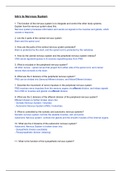Exam (elaborations)
Anatomy and Physiology II 102: Neurology Review Questions (Intro to Nervous System)
- Institution
- Thompson River University (TRU )
Intro to Nervous System 1. The function of the nervous system is to integrate and control the other body systems. Explain how the nervous system does this. Nervous system processes information and sends out signals to the muscles and glands, which causes a response. 2. List the 2 parts of th...
[Show more]



